Pangas Fish Farming Method.
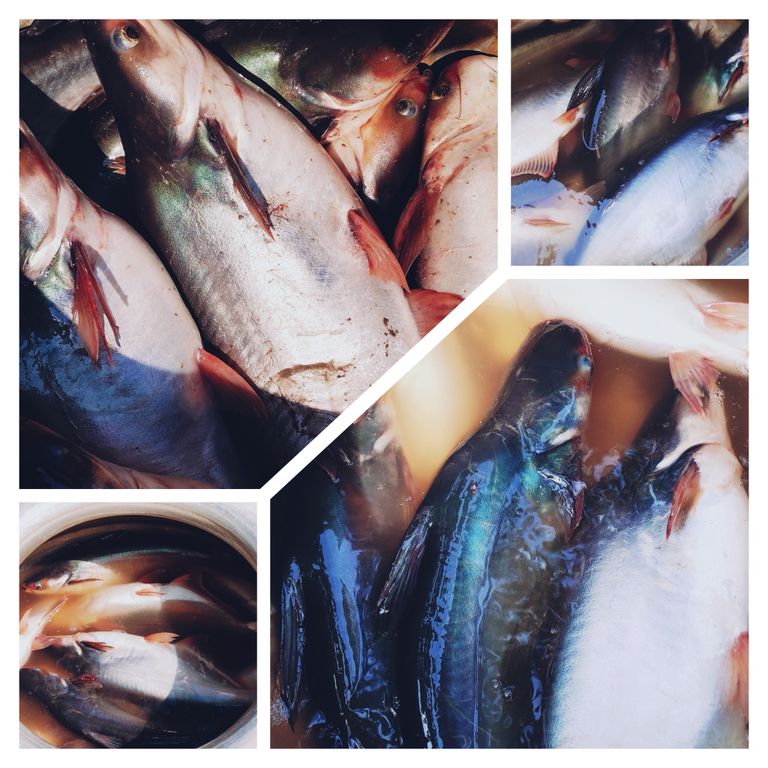
Pangas (Pangasius) is a popular freshwater fish that is widely farmed due to its fast growth, resilience, and high market demand. It is well-suited for commercial farming because of its ability to thrive in diverse environmental conditions. This guide will provide a comprehensive overview of the Pangas fish farming method, focusing on pond preparation, fish stocking, feeding, water quality management, disease control, and harvesting.
1. Selection of Site and Pond Preparation
The first step in Pangas fish farming is selecting a suitable site and preparing the pond properly. The success of the fish farm largely depends on these factors:
Site Selection: Choose a site that has a reliable water source, good drainage, and appropriate soil quality for pond construction. Clay-loam soil is ideal for pond construction as it holds water well.
Pond Size and Shape: A pond size of about 0.25-1 hectare is typically used for Pangas fish farming, though larger ponds are also suitable for commercial farming. Ponds should be 1.5 to 2 meters deep to allow adequate movement of fish and proper oxygen distribution.
Pond Construction: Construct dykes or bunds around the pond to prevent flooding and water leakage. Proper drainage channels should be established to ensure good water flow.
Pond Preparation:
- Liming: Before stocking, apply lime (CaO or CaCO3) to neutralize soil acidity and reduce harmful pathogens. The recommended dose is 250-300 kg per hectare.
- Fertilization: Fertilize the pond with organic manure or chemical fertilizers to promote plankton growth, which serves as the natural food for Pangas fry. Use cow dung at 1,000 kg/ha or urea and TSP at 50 kg/ha each.
2. Fish Stocking
Stocking is the process of introducing fish fry or fingerlings into the pond. Proper stocking density ensures that the fish grow well without overcrowding.
Selection of Fingerlings: Use healthy, disease-free fingerlings from a reputable hatchery. Fingerlings should be uniform in size, active, and free from any visible signs of disease or deformity.
Stocking Density: The ideal stocking density for Pangas fish is 30-35 fingerlings per square meter. This high stocking density is possible due to the species' tolerance to low oxygen levels and its rapid growth rate.
Acclimatization: Before releasing the fingerlings into the pond, acclimatize them to the pond water by keeping them in a container with pond water for 15-30 minutes. This reduces the risk of stress and mortality.
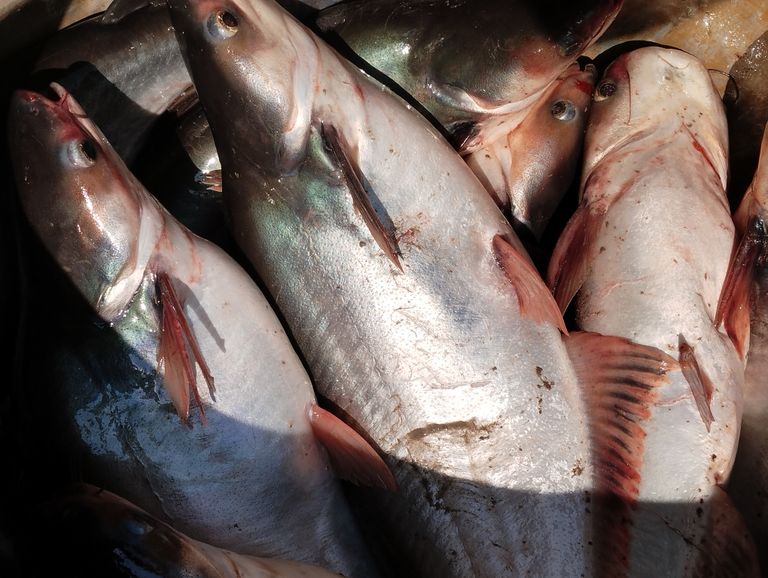
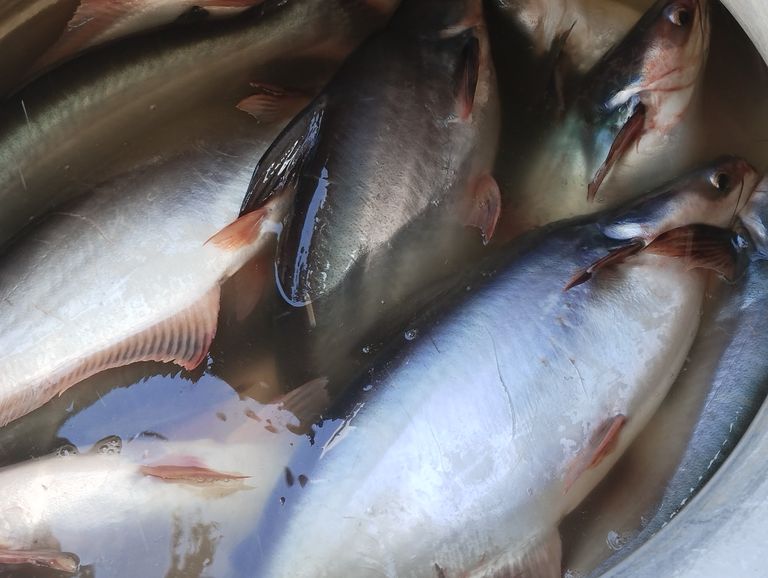
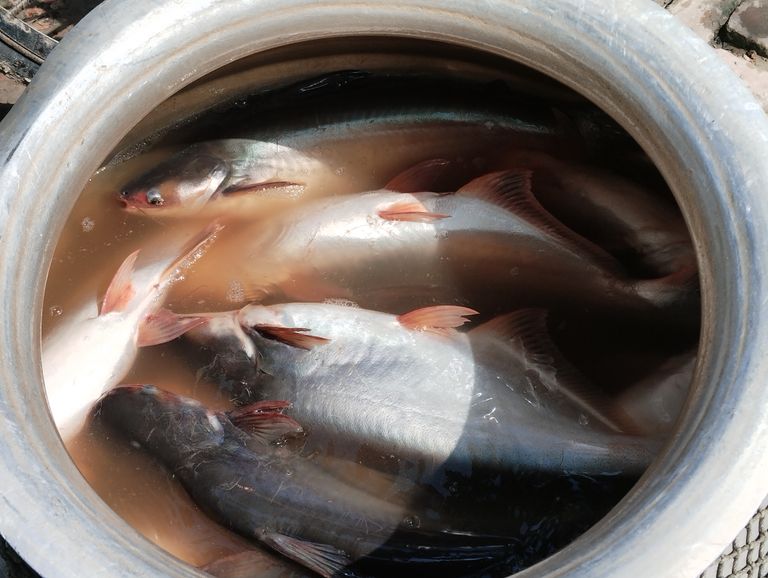
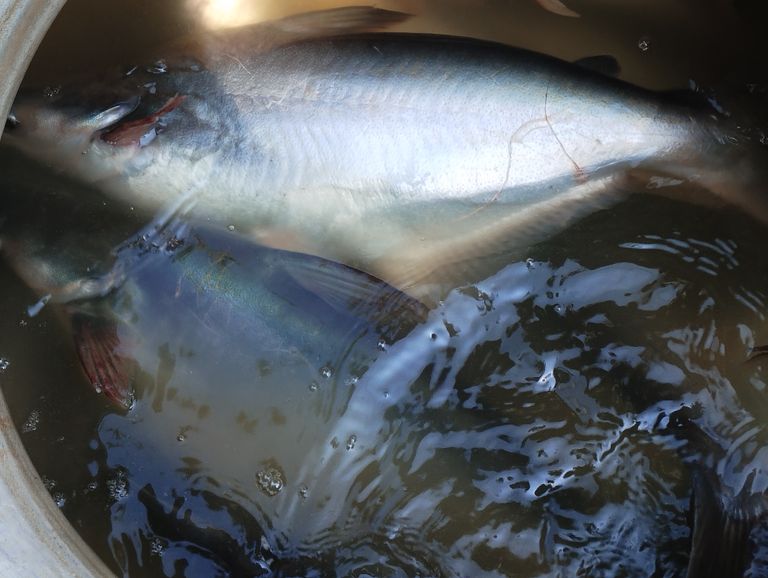
3. Feeding Management
Pangas is an omnivorous species, feeding on both plant and animal matter. In commercial farming, supplementary feeding is essential for optimal growth.
Natural Food: Pangas fry can feed on zooplankton and phytoplankton present in the pond. Ensuring the presence of natural food in the pond is vital, especially during the early stages of growth.
Supplementary Feed: Provide high-quality pellet feed to ensure faster growth. Feed should have a protein content of 28-32%, and feeding should be done two to three times a day.
- Feeding Schedule:
- Fry Stage (First Month): Feed at 10-12% of the body weight.
- Fingerling Stage (1-3 Months): Feed at 8-10% of the body weight.
- Growing Stage (3-6 Months): Feed at 5-6% of the body weight.
- Feeding Schedule:
Feed Management: Monitor feeding closely to avoid overfeeding, which can lead to water pollution. Provide feed according to fish size and weight, and adjust as the fish grow.
4. Water Quality Management
Maintaining good water quality is crucial for the healthy growth of Pangas fish. Regular monitoring and managing water parameters are essential.
Water Depth: Maintain a water depth of 1.5-2 meters throughout the farming period. Ensure that water levels do not drop too low during the dry season.
Dissolved Oxygen (DO): Pangas can tolerate low oxygen levels, but maintaining dissolved oxygen at a minimum of 4-5 mg/L is recommended. Aerate the pond using paddlewheels or blowers if oxygen levels drop significantly.
pH Level: Keep the pH between 6.5 and 8.5, which is ideal for Pangas fish. Regular liming helps to maintain the pH balance.
Water Exchange: Replace 10-15% of the pond water every two weeks to prevent water stagnation and reduce the risk of disease outbreaks.
5. Disease Control and Health Management
Pangas fish are hardy and resistant to many common fish diseases, but they can still be affected by poor water quality, overstocking, and improper feeding.
Common Diseases:
- Fungal Infections: Caused by Saprolegnia species, leading to white patches on the skin.
- Bacterial Infections: Aeromonas and Pseudomonas can cause ulcers, fin rot, and hemorrhaging.
- Parasitic Infections: External parasites like Argulus and Trichodina can affect fish health.
Prevention:
- Maintain good water quality and avoid overstocking.
- Use high-quality feed to boost the immune system of the fish.
- Regularly monitor fish health and remove any sick or dead fish from the pond.
Treatment: In case of disease outbreaks, apply appropriate medications, such as potassium permanganate or formalin, under the guidance of a fish health expert.
6. Harvesting
Pangas fish reach marketable size within 6-8 months, depending on the farming conditions. The average weight at harvest is 800 grams to 1.2 kilograms per fish.
Harvesting Method: Drain the pond partially to make harvesting easier, and then use drag nets or scoop nets to collect the fish.
Post-Harvest Handling: Handle the harvested fish with care to avoid physical damage. Immediately chill the fish in ice to maintain freshness until they are transported to the market.
7. Marketing
Pangas has a high market demand due to its mild taste and boneless fillet. It is widely consumed domestically and exported to international markets.
- Local Market: Fresh Pangas fish can be sold directly to local markets or wholesalers.
- Processing: Some farmers may choose to sell their fish to processing plants, where the fish are processed into fillets, frozen, and exported.
Conclusion
Pangas fish farming is a profitable venture if managed properly. By ensuring the right pond preparation, stocking density, feeding, water quality management, and disease control, farmers can achieve high yields and good profits. Continuous learning and adapting modern aquaculture techniques will further enhance the productivity and sustainability of Pangas fish farming.
Pangas Fish Fry (Pangasius) Farming Guide
Pangas fish, also known as Pangasius, is a popular freshwater fish species native to South and Southeast Asia. It is well-suited for aquaculture due to its fast growth, high yield, and ability to thrive in a variety of water conditions. This guide will explore the step-by-step process of farming pangas fish fry, focusing on key aspects such as pond preparation, stocking density, feeding, water management, and disease control.
1. Site Selection and Pond Preparation
The first step in pangas fry farming is selecting a suitable site for pond construction or identifying existing ponds that can be used for this purpose.
Site Selection:
- Choose a location with easy access to a water source, ensuring that the water is clean and free from pollutants.
- Ensure the area has good drainage to avoid waterlogging.
- The pond should be exposed to sunlight to help maintain optimum water temperature and quality.
Pond Design and Construction:
- The pond should be 1-2 meters deep with a surface area of 0.2-1 hectare, depending on the scale of farming.
- Ensure proper pond embankments to avoid overflow during heavy rainfall.
- Construct drainage systems to manage water levels effectively.
Pond Preparation:
- Before stocking the pond with pangas fry, it is essential to prepare the pond by drying it and removing unwanted weeds and pests.
- Apply lime (CaCO₃) at a rate of 200-250 kg per hectare to neutralize pond acidity and kill harmful organisms.
- After liming, fill the pond with water and fertilize it with organic or chemical fertilizers (cow dung, urea, and superphosphate) to promote the growth of natural food organisms like plankton.
2. Stocking Pangas Fry
Selecting Healthy Fry:
- Healthy pangas fry can be sourced from certified hatcheries or nurseries.
- Choose fry that are 2-3 inches in size, active, and free from any visible deformities or signs of disease.
- Transport the fry carefully to avoid stress and mortality during stocking.
Stocking Density:
- The stocking density of pangas fry depends on the pond’s size and water management system. For extensive culture, stock 10,000-15,000 fry per hectare. For semi-intensive or intensive culture systems, stock up to 25,000-30,000 fry per hectare.
- Gradually acclimatize the fry to the pond’s water temperature before releasing them to minimize stress.
3. Feeding Management
Proper feeding is critical for the healthy growth of pangas fish.
Natural Food:
- In the initial stages, the pond should have a sufficient amount of plankton, which serves as a natural food source for the fry.
- Supplement the natural food with external feeds as the fry grow larger and demand more nutrition.
Supplementary Feeds:
- Feed the fry with protein-rich feed containing at least 30-35% protein for optimal growth.
- Start with finely ground feed for fry, and as they grow, introduce pellet feed to meet their nutritional requirements.
- Feed the fish 2-3 times a day, ensuring that the feed is distributed evenly throughout the pond.
Feeding Schedule:
- Monitor the feeding rate and growth of the fish regularly. Adjust the feeding rate based on the fish’s size and water temperature.
- Ensure the feed is of good quality and avoid overfeeding, as uneaten feed can degrade water quality.
4. Water Quality and Pond Management
Maintaining water quality is essential for healthy fish growth and disease prevention.
Water Temperature:
- Pangas fish thrive in water temperatures between 25°C and 30°C. Monitor the temperature regularly, especially during seasonal changes.
Dissolved Oxygen (DO):
- The pond should have sufficient dissolved oxygen for the fish to survive and grow. Oxygen levels below 3 mg/L can stress the fish and slow their growth.
- Use aerators to maintain proper oxygen levels in the water, especially in intensive culture systems where stocking density is high.
pH Level:
- The ideal pH range for pangas farming is between 6.5 and 8. Regularly check the pH level, and apply lime if necessary to maintain the desired range.
Water Exchange:
- Partial water exchange should be done every 2-3 weeks to prevent the accumulation of toxic substances like ammonia and to maintain good water quality.
- During water exchange, replace 20-30% of the pond water with fresh water.
5. Disease Management and Health Monitoring
Pangas fish are generally hardy, but they can be susceptible to diseases if the water quality is poor or if they are stressed.
Common Diseases:
- Bacterial Diseases: Bacterial infections can cause ulcers, fin rot, and internal infections. Ensure proper hygiene and avoid overstocking to prevent these issues.
- Parasitic Infestations: External parasites can cause skin irritation and affect fish health. Use approved medications to treat the pond if parasites are detected.
Preventive Measures:
- Maintain good water quality through regular monitoring and water exchange.
- Avoid overfeeding and ensure proper waste management to reduce the risk of disease outbreaks.
- Regularly observe the fish for any signs of illness, such as changes in behavior, reduced feeding, or physical deformities.
6. Harvesting Pangas Fish
Harvest Time:
- Pangas fish usually reach marketable size within 6-8 months, depending on feeding and management practices. The average weight of a marketable fish is 1-1.5 kg.
- To harvest, lower the water level in the pond and use nets to catch the fish.
Post-Harvest Handling:
- Handle the fish carefully to avoid bruising or injury. Properly clean and store the fish in ice to maintain freshness during transportation to markets.
7. Economic Considerations
Cost of Production:
- The cost of pangas fry farming includes expenses for pond preparation, stocking, feed, water management, and disease control.
- The profitability of pangas farming can vary depending on local market prices, feed costs, and the scale of production.
Profitability:
- Pangas fish farming is considered highly profitable due to the species' fast growth rate and high demand in the market.
- Farmers can expect a yield of 8-10 tons of fish per hectare in a well-managed semi-intensive system.
8. Sustainability and Environmental Considerations
Sustainable Practices:
- Implement sustainable farming practices such as using organic fertilizers, reducing water pollution, and minimizing the use of antibiotics and chemicals.
- Integrated aquaculture systems, where pangas farming is combined with other agricultural activities, can help reduce environmental impact and increase overall farm productivity.
Environmental Impact:
- Overfeeding and improper waste management can lead to water pollution and negatively affect the surrounding ecosystem.
- Proper pond management, water filtration, and waste recycling systems can minimize the environmental footprint of pangas farming.
Conclusion
Pangas fish fry farming offers significant economic potential for small and large-scale fish farmers. With proper site selection, pond preparation, feeding management, and disease control, farmers can achieve high yields and meet the growing demand for this popular fish. Sustainable and responsible farming practices will not only ensure profitability but also contribute to the long-term health of the environment.
The Health Benefits of Eating Pangasius Fish
Introduction
Pangasius fish, commonly known as pangas or basa, is a type of freshwater fish that has gained significant popularity in various parts of the world due to its affordability and mild taste. Originally from Southeast Asia, particularly Vietnam, Pangasius has become a staple in many households and restaurants globally. This fish is known for its tender, flaky texture, making it versatile for many culinary dishes. But beyond its culinary appeal, Pangasius fish offers a range of health benefits that make it an excellent addition to your diet. This blog will explore the various nutritional and health advantages of consuming Pangasius fish, while also touching on potential concerns and how to incorporate it into your meals.
Nutritional Value of Pangasius Fish
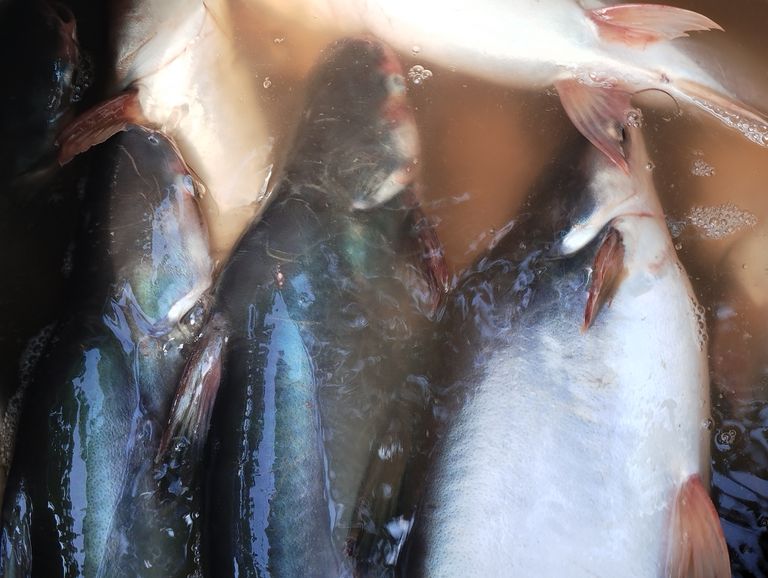
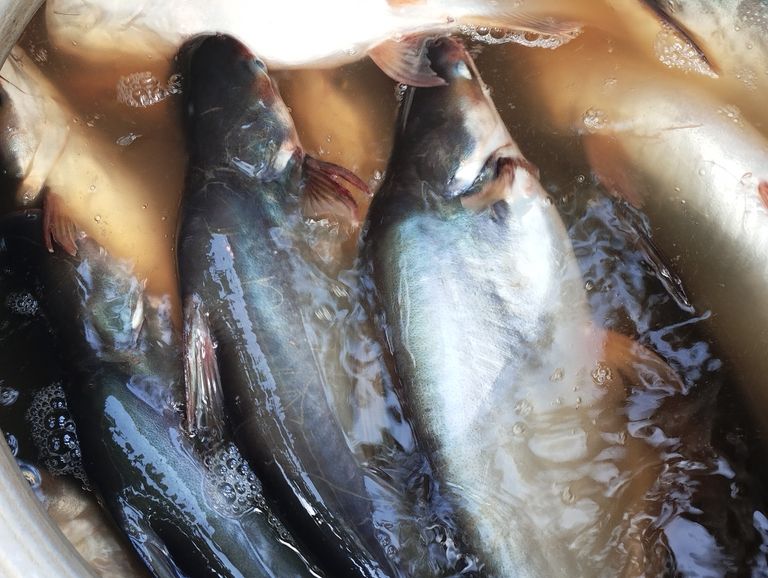
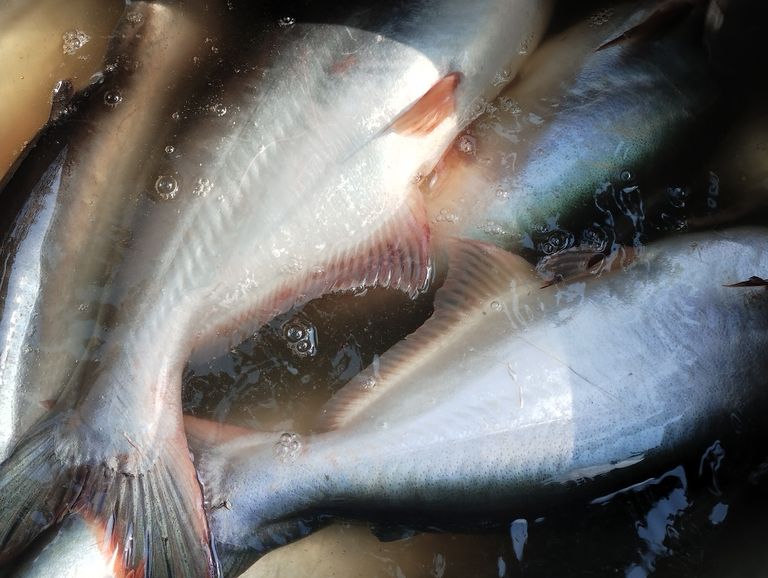
Pangasius is not just an affordable and tasty choice; it is also a highly nutritious food. Here is a breakdown of its nutritional components:
Low in Calories: A 100-gram serving of Pangasius contains only about 100-120 calories, making it an ideal choice for those who are monitoring their calorie intake. Its low-calorie content is one of the reasons it's so popular among those looking for a lean protein source.
High in Protein: This fish is rich in protein, which is essential for muscle repair, growth, and overall body function. A single 100-gram serving provides around 15-20 grams of protein. Protein is a macronutrient that helps to keep you full and supports metabolism, making Pangasius a great option for anyone following a high-protein diet.
Low in Fat: One of the standout features of Pangasius fish is its low-fat content. It contains less than 5 grams of fat per 100 grams, and the fat it does contain is mostly unsaturated, which is beneficial for heart health.
Omega-3 Fatty Acids: Although Pangasius is not as rich in omega-3 fatty acids as some other fish like salmon or mackerel, it still contains a small amount of these essential fats. Omega-3s are known to support brain health, reduce inflammation, and improve cardiovascular health.
Rich in Essential Vitamins and Minerals: Pangasius fish contains important nutrients like vitamin D, B12, and selenium. Vitamin D is crucial for bone health and immune function, while B12 supports nerve function and red blood cell production. Selenium acts as an antioxidant and helps to protect cells from damage.
Health Benefits of Pangasius Fish
1. Supports Heart Health
Pangasius fish can contribute to heart health due to its low saturated fat content and the presence of omega-3 fatty acids. Although the levels of omega-3 are lower compared to fatty fish, the small amounts still provide some cardiovascular benefits. Regular consumption of omega-3 fatty acids is associated with reduced risks of heart disease, improved cholesterol levels, and lower blood pressure.
2. Promotes Muscle Growth and Maintenance
Since Pangasius is high in protein, it is an excellent food for those looking to build or maintain muscle mass. Protein plays a critical role in the repair and growth of muscle tissues, especially after exercise. This makes Pangasius a perfect addition to post-workout meals for athletes or fitness enthusiasts.
3. Weight Management
The low calorie and fat content of Pangasius make it a great choice for individuals who are trying to lose weight or maintain a healthy weight. Protein-rich foods like Pangasius also help to promote a feeling of fullness, which can reduce the tendency to snack between meals and control overall calorie consumption.
4. Supports Bone and Teeth Health
Pangasius fish is a good source of vitamin D, which plays a crucial role in maintaining strong bones and teeth. Vitamin D helps the body absorb calcium, which is essential for bone health. Consuming enough vitamin D can help prevent bone disorders such as osteoporosis and fractures.
5. Boosts Immune Function
The presence of selenium in Pangasius fish helps boost the immune system. Selenium is a powerful antioxidant that fights oxidative stress and protects the body from chronic diseases, including cancer. It also supports thyroid health, which regulates metabolism and immune response.
6. Improves Brain Function
Omega-3 fatty acids are known to support cognitive function, memory, and overall brain health. While Pangasius is not the richest source of omega-3s, consuming it still provides some cognitive benefits, particularly in combination with other omega-3-rich foods. Vitamin B12 in Pangasius also supports brain health by promoting healthy nerve function and reducing the risk of cognitive decline as you age.
7. Good for Skin and Hair
The nutrients found in Pangasius fish, such as omega-3 fatty acids, vitamin D, and protein, are all beneficial for maintaining healthy skin and hair. Omega-3s help reduce skin inflammation, while protein provides the building blocks for strong, healthy hair. Regular consumption of this fish can contribute to a glowing complexion and improved hair texture.
Potential Concerns
While Pangasius fish offers many health benefits, there are some concerns to be aware of, especially regarding its farming practices. Most Pangasius available on the market is farmed, often in countries where regulations may vary. Some reports have raised concerns about water contamination and the use of antibiotics in fish farms. To avoid these issues, it’s important to purchase Pangasius from reputable sources that follow responsible farming practices and have certifications for sustainability.
How to Cook and Enjoy Pangasius Fish
Pangasius is a versatile fish that can be cooked in many ways. Its mild flavor makes it a good match for various seasonings and cooking methods. Here are some ideas:
- Grilled: Marinate the fish with herbs and spices, and grill it for a light, healthy meal.
- Pan-fried: Lightly coat the fish in flour or breadcrumbs, then pan-fry it for a crispy, golden finish.
- Baked: Bake Pangasius with vegetables and olive oil for a low-fat, nutritious dish.
- Steamed: Steam the fish with ginger and soy sauce for an Asian-inspired meal that’s gentle on the digestive system.
It can be served with a variety of sides such as rice, quinoa, steamed vegetables, or a fresh salad. Its mild taste allows it to complement numerous ingredients and flavors, making it an excellent fish for experimenting with in the kitchen.
Conclusion
Pangasius fish is a nutritious, low-calorie, and protein-rich food that can be beneficial for your overall health. It supports heart health, aids in weight management, promotes muscle growth, and provides essential vitamins and minerals like vitamin D, B12, and selenium. While concerns about farming practices exist, choosing responsibly sourced Pangasius can mitigate these risks. Its versatility in cooking makes it a delightful and easy addition to your regular meal plan, providing you with a range of health benefits while also satisfying your taste buds.
Incorporating Pangasius into your diet can be a smart and health-conscious choice, especially if you're looking for a lean, affordable, and nutritious source of protein.
Pangas fish, commonly known as Pangasius, is a freshwater fish species that holds significant medicinal and nutritional value. Widely consumed across Asia, especially in countries like Bangladesh, India, and Vietnam, Pangasius fish is not only a popular choice for its taste but also for its health benefits. This blog will explore the medicinal properties of Pangas fish, its nutritional profile, and how its regular consumption can promote overall health and well-being.
Nutritional Profile of Pangas Fish
Before delving into the medicinal properties, it's essential to understand the nutritional composition of Pangas fish. It is a lean source of protein and is rich in several essential nutrients, including:
- High-Quality Protein: Pangas fish is an excellent source of protein, providing the body with essential amino acids that are crucial for muscle growth, tissue repair, and overall body function.
- Omega-3 Fatty Acids: While the fish does not have as high omega-3 content as fatty fish like salmon, it still contains a decent amount of these essential fatty acids, which play a critical role in heart and brain health.
- Low in Fat: Pangas fish is low in fat, making it an ideal choice for those looking to reduce their fat intake without compromising on essential nutrients.
- Vitamins and Minerals: It is rich in vitamins like Vitamin D and B12, and minerals such as phosphorus and selenium, which are vital for bone health, immunity, and the proper functioning of the nervous system.
Medicinal Properties of Pangas Fish
Heart Health:
One of the most well-known benefits of Pangas fish is its contribution to heart health. The omega-3 fatty acids found in the fish are known to reduce the risk of cardiovascular diseases by lowering triglyceride levels, reducing blood pressure, and preventing the buildup of plaque in the arteries. Regular consumption of Pangas fish can help reduce the risk of heart attacks, strokes, and other cardiovascular conditions.Anti-Inflammatory Properties:
Omega-3 fatty acids also have potent anti-inflammatory properties. These compounds help reduce inflammation in the body, which can lower the risk of chronic diseases such as arthritis, asthma, and certain autoimmune disorders. By incorporating Pangas fish into your diet, you can support the body's natural anti-inflammatory responses, potentially alleviating symptoms of inflammation-based conditions.Brain Health and Cognitive Function:
The presence of omega-3 fatty acids, particularly DHA (Docosahexaenoic Acid), in Pangas fish plays a crucial role in brain development and cognitive function. Regular consumption of these fatty acids is associated with improved memory, focus, and overall brain health. In older adults, omega-3s are linked to a reduced risk of neurodegenerative diseases such as Alzheimer's and dementia.Promotes Weight Management:
Pangas fish is low in calories and fat, making it an excellent choice for those looking to manage their weight. The high protein content in the fish helps promote satiety, keeping you feeling full for longer periods and reducing the likelihood of overeating. Additionally, the lean protein supports muscle maintenance and growth, which is essential for individuals aiming to lose weight or maintain a healthy body composition.Boosts Immunity:
The essential vitamins and minerals present in Pangas fish, particularly Vitamin D, selenium, and zinc, play a crucial role in supporting the immune system. Vitamin D is known to enhance the pathogen-fighting effects of monocytes and macrophages, white blood cells that are important parts of the immune defense. Selenium, a powerful antioxidant, helps protect the body from oxidative stress and strengthens the immune system.Supports Bone Health:
Phosphorus and Vitamin D in Pangas fish contribute significantly to bone health. Phosphorus is a critical component of bones and teeth, while Vitamin D facilitates calcium absorption, which is vital for maintaining bone density and preventing diseases like osteoporosis. Consuming Pangas fish regularly can help keep bones strong and reduce the risk of fractures in older adults.Improves Skin and Hair Health:
The omega-3 fatty acids and protein content in Pangas fish also promote healthy skin and hair. Omega-3s hydrate the skin, reduce acne, and prevent premature aging. Additionally, the proteins in the fish provide essential nutrients required for the growth and repair of skin and hair tissues. Regular consumption of Pangas fish can lead to radiant skin and healthier hair over time.Regulates Cholesterol Levels:
Pangas fish is known to have a beneficial effect on cholesterol levels. The lean protein and omega-3 fatty acids work together to reduce bad cholesterol (LDL) and increase good cholesterol (HDL) in the blood. This balance helps in maintaining overall cardiovascular health and reduces the risk of heart-related ailments.Antioxidant Properties:
The fish is a good source of selenium, which has antioxidant properties. Antioxidants are crucial for neutralizing free radicals, which are unstable molecules that can damage cells and contribute to aging and diseases like cancer. Selenium also supports the thyroid gland, which regulates various metabolic processes in the body.
How to Incorporate Pangas Fish into Your Diet
To reap the medicinal benefits of Pangas fish, it is important to include it in your diet in a balanced manner. Here are a few suggestions on how to enjoy this nutritious fish:
- Grilled or Baked: One of the healthiest ways to prepare Pangas fish is by grilling or baking it. This method helps retain its nutritional value while adding minimal extra calories.
- Fish Curry: In many parts of Asia, Pangas fish is cooked into a flavorful curry with various herbs and spices, which enhances its taste and boosts its health benefits.
- Fish Soup: A light fish soup can be a perfect meal, providing warmth and nutrition without being too heavy on the stomach.
- Pan-Seared: A quick pan-seared Pangas fillet with olive oil, garlic, and herbs can be a simple yet delicious way to enjoy this fish.
Precautions and Considerations
While Pangas fish offers several health benefits, it is important to consider a few precautions:
- Sourcing: Ensure that the Pangas fish you consume is sourced from clean and regulated environments. In some regions, concerns have been raised regarding the farming practices of Pangas fish, particularly about the use of contaminated water and feed. Opt for certified organic or responsibly farmed fish to avoid potential health risks.
- Mercury Levels: Like many other fish, Pangas fish can sometimes contain traces of mercury. Although the levels are usually low, it is wise to limit consumption to moderate amounts, especially for pregnant women and young children.
Conclusion
Pangas fish is not only a delicious and versatile ingredient in various cuisines but also offers numerous medicinal and health benefits. From promoting heart and brain health to boosting immunity and supporting weight management, the inclusion of this fish in your diet can contribute to overall wellness. However, it is crucial to source the fish responsibly and consume it in moderation to maximize its benefits without any potential risks.
Incorporate Pangas fish into your meals today and enjoy the wide range of health advantages it provides.
Telegram and Whatsapp